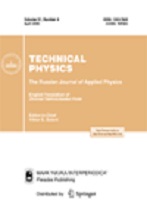|
This article is cited in 1 scientific paper (total in 1 paper)
Solid-State Electronics
Magnetization of paraffin-based magnetic nanocolloids
Yu. I. Dikansky, A. G. Ispiryan, S. Kunikin, A. V. Radionov
North-Caucasus Federal University, Stavropol, Russia
Abstract:
Using paraffin-based magnetic nanocolloids as an example, the reasons for maxima in the temperature dependence of the magnetic susceptibility of magnetic colloids have been discussed. The behavior of these dependences in a wide temperature interval has been analyzed for colloids in solid and liquid states. It has been concluded that the maximum observed at the melting point of paraffin can be attributed to freezing Brownian degrees of freedom in magnetite coarse particles, the magnetic moment of which is intimately related to the solid matrix. The second main maximum, which arises in the solid state, is explained by the superparamagnetic-magnetically hard transition of most fine particles at lower temperatures. It has been noted that the flatness of this maximum results from the polydispersity of the magnetic nanoparticle ensemble.
Received: 28.06.2016
Revised: 25.05.2017
Citation:
Yu. I. Dikansky, A. G. Ispiryan, S. Kunikin, A. V. Radionov, “Magnetization of paraffin-based magnetic nanocolloids”, Zhurnal Tekhnicheskoi Fiziki, 88:1 (2018), 58–62; Tech. Phys., 63:1 (2018), 57–61
Linking options:
https://www.mathnet.ru/eng/jtf6018 https://www.mathnet.ru/eng/jtf/v88/i1/p58
|


| Statistics & downloads: |
| Abstract page: | 61 | | Full-text PDF : | 39 |
|





 Contact us:
Contact us: Terms of Use
Terms of Use
 Registration to the website
Registration to the website Logotypes
Logotypes








 Citation in format
Citation in format 
